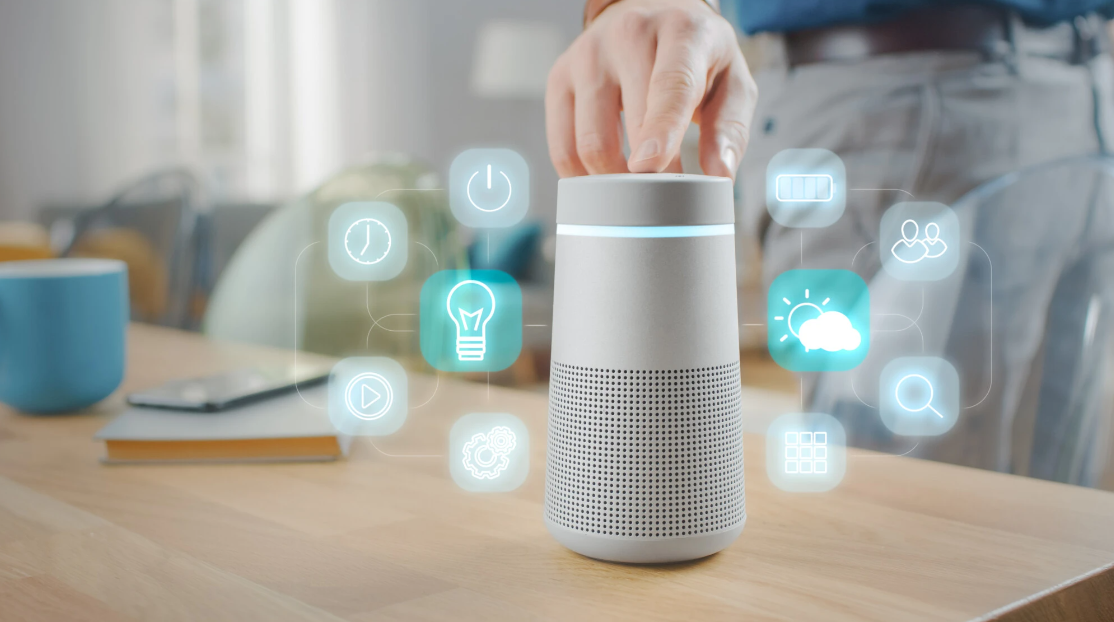AI in everyday life: prejudices, opportunities and the responsible use of modern technology

Artificial intelligence (AI) is one of the most important trends of the digital age. A large number of companies already rely on this innovative technology. Whether for development, in administrative tasks or for production. But AI can also make our everyday lives easier in many ways. In some areas we discover them obviously, in others more at second glance. We show where AI is already supporting us today and which measures are necessary for a responsible use of the technology.
From the smart home to voice control: Here’s how AI can be integrated into everyday life
Everyone knows it, almost everyone uses it: Artificial intelligence (AI). Whereas until a few years ago advanced technology was used almost exclusively by companies, today it has found its way into almost every household. Whether voice control, translation tools, home automation or navigation systems– in many areas, technology is increasingly making our everyday lives easier.
With the help of AI, technical systems can better perceive their environment, analyze it, solve problems through learning, and thus achieve certain goals. They are therefore able to adapt their actions accordingly to newly learned situations. Thanks to the countless amounts of data available on the Internet today, the development of AI has progressed rapidly since the beginning of the 2000s – “Big Data” is the keyword. For example, 85 percent of online commerce today is already conducted with AI.
As the demand for everyday AI has also increased significantly in recent years, we would like to take a look at the many optionsand ask ourselves what responsible use of the technology actually looks like.
Smart Home
The smart, connected home is taking on an increasingly important role for many of us. Automatic shutters, sophisticated security programs, automated coffee machines, self-adjusting lighting conditions or an always comfortable room climate – it’s the little things in life that make everyday life feel a little easier. Especially in times of lockdown, home office and house building boom, the optimization of one’s own four walls to a smart home reaches a new particularly high significance. After all, the convenience that technology offers us has increased significantly in recent years.
This way we can control the heating even if we are not at home yet, so that we can come to the warmed up apartment on a cool autumn day. Awnings can be retracted when rain or a storm is forecast. There is almost nothing left that cannot be controlled and programmed according to our preferences. In the process, we give the AI all the data it needs to execute correctly over a period of time and, depending on the scope, everything eventually runs completely automatically. Once we have “fed” the AI with enough data, our refrigerator can, for example, place the next grocery order based on our shopping behavior, and the lights in our premises will adjust automatically according to time of day and presence.
But as always, there is a risk: Because in a fully networked house or the associated device, personal data is stored. Data that can be used to draw conclusions about the respective residents and, for example, their times of presence and absence at home. This allows burglars, for example, to get an overview of when you are home.. For this reason, caution is advised as to what data you explicitly want to share with the software.
Voice assistance
Wer kennt sie nicht? Alexa, Cortana, Siri and Co. are among the most widespread voice control tools – also called voice assistants in English. True, some of them have small errors now and then. Nevertheless, you can literally see how they are gaining intelligence. By means of so-called machine learning, voice assistants recognize special patterns within the volumes of data that they pick up via “communication” with us and can provide increasingly precise answers over time. For example, when asked what the weather will be like today, what time it is, or what the traffic situation is like on the route to work. Online orders can now also be placed with ease via Voice Assistance.
Music and video streaming
We also encounter AI in the area of music and video streaming – a simple form of it, to be sure. For all music suggestions based on our most recently listened to songs, as well as new series and movies “that we might also like” invoke AI information. In this case, the AI learns more and more about our individual music and movie tastes and spits out its recommendations for us accordingly.
Assisted Driving & Navigation
It will probably be several years before autonomous driving is fully established as safe. However, there are already some functions that bring us a step closer to autonomous driving and make the driving experience a lot more pleasant. These functions include, for example, the so-called proximity control, special emergency braking assistants, automatic traffic sign recognition and automatic parking assistance.
The AI has the task of correctly assessing situations while driving. For example, a plastic bag on the road is not a reason for an emergency brake, and not every shadow is a risk when parking. Thanks to image recognition, the AI in can also recognize speed limits, for example, and remind the driver of the speed limit in good time. Thus, it represents a safety factor even at high speeds – which of course does not mean that you should rely completely on the AI. Even navigation systems now rely on AI for accurate route calculation. Because thanks to the right analysis, Google Maps or other navigation systems can tell us which route is the fastest or how we can best avoid the traffic jam in order to arrive on time for the appointment after all.

Face recognition
More and more smartphones have facial recognition. This allows you to, regardless of the lighting conditions, but also to unlock their smartphone or certain apps only with the help of the so-called face scan. Behind this function is also the use of artificial intelligence. That’s because algorithms in our smartphone are working to analyze our facial features more precisely every time we look at them.
The more information is stored about our appearance – whether in the morning after getting up, without or with make-up on, or with different hairstyles – the quicker and better we can remove the display lock or, for example, change it. Perform verifications as part of online banking or new social media accounts. But facial recognition is not only used on cell phones. Manufacturers of smart home or home security systems also use the technology (e.g. for unlocking front doors, etc.).
Filtering advertisements
Another area where we find AI in daily life is in filtering ads and spam emails. Do you know it too? You open your email inbox and occasionally discover mail that you would consider spam. Without AI, the number of these mails would probably be even greater. For example, email providers have made it their business to identify junk or spam emails using AI and banish them directly to the aforementioned “spam folder”. In the process, AI algorithms analyze reams of information to uncover patterns in data streams that indicate spam. These include, for example, formatting, send time, and the number of emails sent from a particular account.
Equally well known as everyday AI is, for example, the algorithm that we encounter on Facebook, for example. This recognizes and analyzes certain clicks, likes, habits, contacts and followers, as well as information about who is in how close contact with whom. As a result, the messages of the “best” friends or those whose content you click on the most are also displayed higher up in the newsfeed. Meanwhile, many other social networks are also resorting to this type of AI. The goal is user optimization and, of course, the potential to broadcast advertising in a more targeted manner. This is because the artificial intelligence uses the “Like”, “Likes” or “Following” options to draw conclusions about which posts or advertisements might be interesting for the respective user. Products can thus be placed in a targeted manner – often without the consumer really being aware in the end that the purchase intention here is actually driven by an AI.
Artificial intelligence: Responsible handling is an absolute must
Every single area of everyday life in which AI is used improves daily life on the one hand, but on the other hand also interferes with our privacy in some way – for some more, for others less. That’s why protecting that privacy and personal information must be a top priority in AI development. Itis the responsibility of manufacturers and developers to pursue this goal and important factor and to protect users from misuse of AI, e.g., through hacker attacks. The more AI becomes part of our everyday lives, the more policymakers will have to address the issues of cybersecurity and data protection and set the appropriate laws and course for optimal and secure use.
Ultimately, everyone can decide for themselves whether or which AI solutions they use in their everyday lives. Most scientists agree that there will be no system in the next few years that can fully replicate humans with all their capabilities. In principle, we should be as open as possible to the topic of AI – whether in everyday life or in business – as it can hold many opportunities and facilitations for us humans, beyond the prejudices. Any risks should always be kept in mind when developing new technologies, strategies, function and the corresponding laws. Thus, the machine remains the helping hand of man.
Video: AI in everyday life | Where we find it and what the future holds
In our latest technology episode of medsolutTV, Vincent Schneider gets to the bottom of artificial intelligence,which accompanies us every day in a wide variety of situations. See for yourself which innovative possibilities have already integrated into our everyday lives and what the future could look like with AI …
Do you have questions about the article or topic requests for a new article? Then don’t be afraid to contact us.




